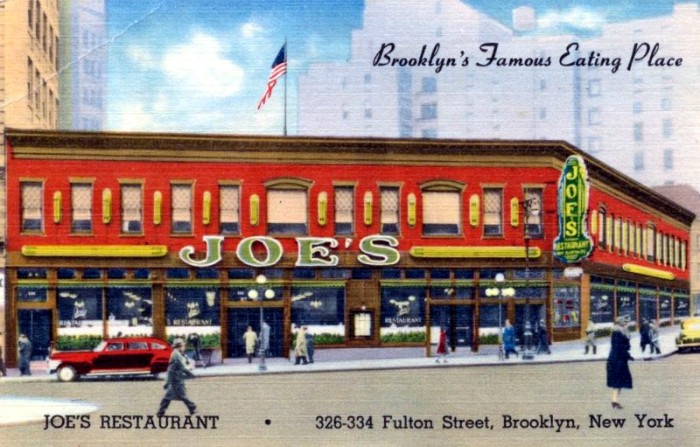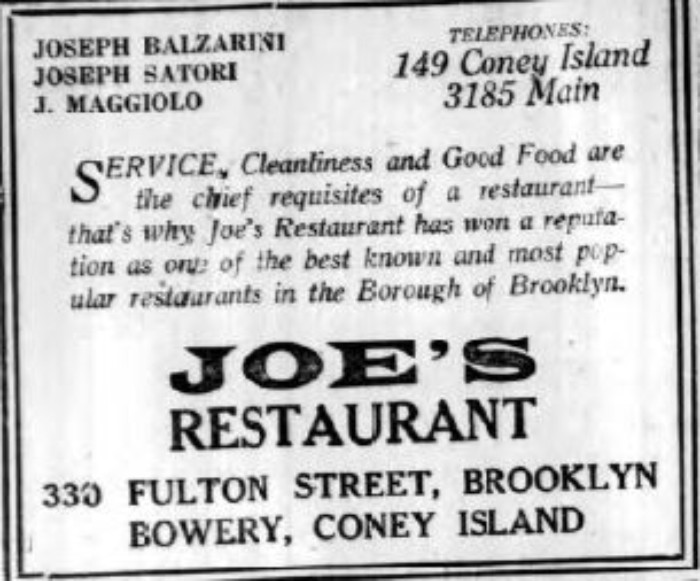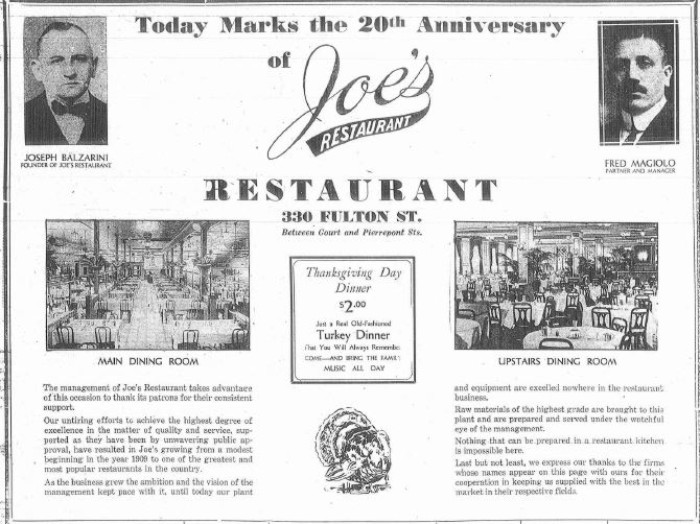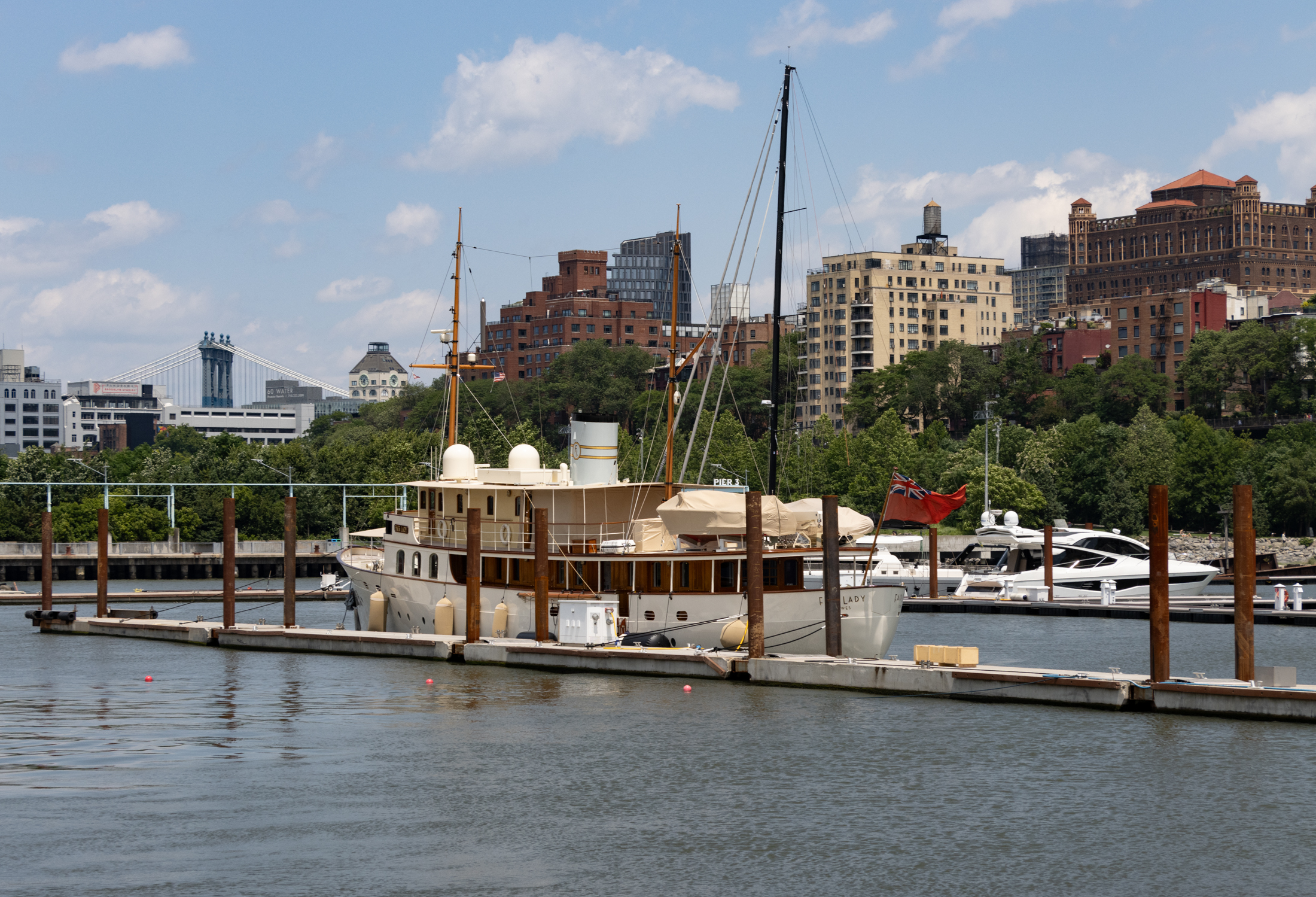Walkabout: Dine at Joe’s, Brooklyn, Part 1
Read Part 2 of this story. A restaurant with a simple name like “Joe’s” hardly seems to be the kind of place where the average diner could rub elbows with the movers and shakers, but that was part of the charm of Joe’s. One part of its vast dining room could be hosting a First…


Read Part 2 of this story.
A restaurant with a simple name like “Joe’s” hardly seems to be the kind of place where the average diner could rub elbows with the movers and shakers, but that was part of the charm of Joe’s. One part of its vast dining room could be hosting a First Communion breakfast, while the banquettes in the back were occupied by some of Brooklyn’s most powerful politicians and power brokers.
A small time mobster, out of prison to testify at a trial of one of the Murder Inc. gang could find himself and his two police handlers a table away from Branch Rickey, the owner of the Brooklyn Dodgers. Awestruck, and still in handcuffs, he would ask Rickey for an autograph for the boys back on the cell block.
This actually happened, and is one of the tales of Joe’s at 330 Fulton Street, on the corner of Pierrepont Street in Brooklyn Heights. But there were actually three famous Brooklyn restaurants named Joe’s, and two Joe’s, so it could get confusing. This is their tale.
Joseph Balzarini was born in Italy in 1861. His family immigrated to Argentina when he was a child, and he came to America at the age of twenty-two to seek his fortune. He started a fruit business in Manhattan, and later opened a restaurant on Water Street, followed by another Manhattan restaurant.
In 1909, he came across the river to Brooklyn, and opened his first Joe’s Restaurant at Coney Island with another Joe; Joseph Sartori. Joseph Sartori was twenty years younger than Balzarini, and was born in 1882. He also immigrated to the United States from Italy, and came here at the age of fourteen, in 1896.
I couldn’t find a definitive version of how they met, or became partners, but the Coney Island Joe’s soon became one of the most popular restaurants at Coney Island. Italian immigrants made up a large part of the immigrant population of New York at the turn of the 20th century, and Coney Island was a hugely popular destination for the “everyman” day tripper, so Joe’s Restaurant, with its delicious home style cooking became a must for many a family outing.
Their menu also included staples like chops, steaks and seafood, and appealed to every palate. It was located on the Bowery, the main street of restaurants, shops, cafés and bars, with excellent foot traffic.
Coney Island is Coney Island, so the Joes wanted to also have a presence in Downtown Brooklyn, a place where they could have a more varied menu, better ambiance, and year round customers. They found the ideal location on the corner of Fulton and Pierrepont Streets, a two story corner building next door and around the corner from Brooklyn’s political and financial heart.
It was perfect. It was also huge, with a large dining room downstairs, and a second story for private events and large groups. Joe’s opened for business, and was soon one of Downtown Brooklyn’s most popular eating establishments.
Fulton Street Joe’s was soon followed by a third Joe’s on Nevins Street, near Flatbush Avenue. I was not able to find any proof, and certainly no stories on the relationship between Joe Balzarini and Joe Sartori, but it seems they either had a falling out, or decided to each take a Joe’s and not interfere with the other, but remained partners.
Newspaper accounts at their deaths give both men possession of all three restaurants, but it seems clear that Joe Balzarini was the force behind the Fulton/Pierrepont Joe’s, while Joe Sartori was the king at the Coney Island and Nevins Street establishments.
While the Downtown Brooklyn restaurants were doing fine, Joe Sartori had not forgotten about Coney Island. He owned a large beachfront hotel, with bathhouses and private beach called the Raven-Hall Hotel. In 1920, he leased them for twenty-one years to a Coney Island management company that planned to expand the bathhouse facilities and beach, and improve the hotel.
It was a very lucrative lease, giving him money for many projects. Meanwhile, Joe Balzarini was expanding the empire Downtown. In 1925, he purchased the Johnson Building on Nevins Street, which housed the Nevins St. Joe’s Restaurant.
They had been leasing the ground floor for two years, and now owned the entire nine story building, which cost them $500,000, the highest price paid for real estate in the area. This enabled them to expand the restaurant all the way back to Grove Street in the back, as well as throughout the rest of the first floor. Joe’s was growing.
The Pierrepont Street Joe’s was growing, too. Located across the street from the courthouses and Borough Hall, it soon became the meeting place of politicians and power brokers.
Brooklyn’s important insurance and financial hub was also just around the corner, as the Downtown skyscraper district developed, and Joe’s was in the perfect place to take advantage of the many customers that could patronize their business and make deals from the family style tables.
A copy of their menu from the 1920s lists over 400 food choices, from appetizers to dessert. Their kitchens were humming with activity, and the large staff was busy.
Everyone associated with Joe’s soon became a minor celebrity, as wait staff and management became a part of Brooklyn’s cultural life. One of them, a young man named Mario Malchidi, had only been in America for a couple of years when he enlisted in the cavalry during World War I.
He was known at Joe’s as “the kid with the big smile,” an affable young man who enlisted to serve his new country, and to better learn English. He survived the war, travelled all over Europe in the process, and was even able to drop in on his mother in Italy, before coming back to the United States at the end of the war.
By that time, his English was superb, and he had picked up French and German, as well. He went back to work at Joe’s and by 1932 was the manager there.
Pierrepont St. Joe’s celebrated its 20th anniversary in 1929, with a full page ad in the Brooklyn Eagle. By that time, there was also a new name on the roster, Fred Magiolo, who had become manager and partner.
According to his obituary, he was partners with both Joes, and helped in the management of both the Nevins and Fulton Street establishments. Joe’s expanded on Pierrepont as well, and Joseph Balzarini opened Balzarini Wine and Liquor right next door to the restaurant in 1935, selling the wines and spirits that were flowing next door. Prohibition was over.
While power brokers and politicians were patrons at Joe’s, the restaurants’ bread and butter were the common people, especially the Catholics. Throughout the history of the restaurant, there were countless banquets and celebrations by Catholic organizations and church groups.
There were First Communion breakfasts, hundreds of them, as well as wedding parties, Confirmation dinners, and birthday parties. Brooklyn’s church leadership had breakfasts, banquets, and celebrations for retirements, birthdays, and ecclesiastical promotions and anniversaries.
There were also Catholic lay groups who had breakfasts, lunches and dinners there, as well as other non-Catholic civic and business groups, including clubs, teachers, and union groups.
Branch Rickey’s Brooklyn Dodgers had their offices next door to the restaurant, too, in the bank and office building that loomed over the restaurant, on the corner of Montague and Fulton, and he was a fixture there.
Mr. Rickey invited the Voice of the Dodgers, announcer Red Barber to lunch at his favorite table at Joe’s when he announced to Barber that he was going to hire a Negro player to play with the team. At the time, he didn’t know who that would be, but it was going to happen.
Barber, who was from the South, almost quit the team, unable to come to terms with integration. He would come around later. Joe’s would see many more changes, at both Downtown locations, before the end.
Next time: What happened to Joe’s? Seems like restaurants that popular would be here forever. Joe’s on Nevins Street is gone, as is Joe’s on Fulton.
Fulton Street at Pierrepont is gone, too, the location no longer exists. The conclusion of the story is next time, when we look at the death of one of Brooklyn’s most beloved institutions. In the case of the Fulton Street Joe’s – the borough that said it loved Joe’s, loved “progress” even more.
(Photo: 1940s linen postcard)








What's Your Take? Leave a Comment